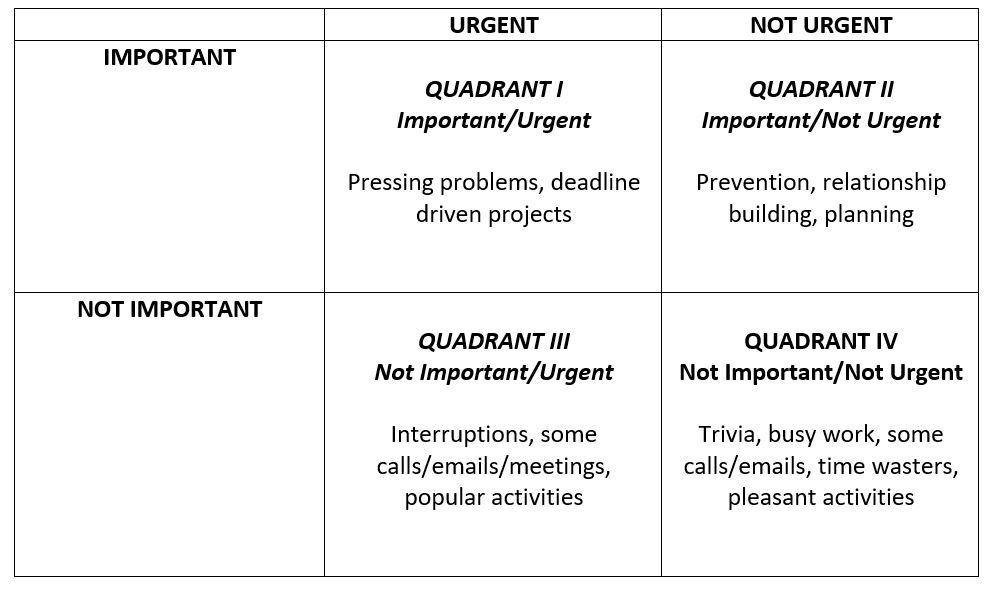How to Prioritize Things in Your Life: 6 Great Techniques
Before we get to today’s blog post on how to prioritize things in your life, I want to tell you a little story. It’s a story about the mayonnaise jar and the cup of coffee and it goes like this:
A professor stood before his philosophy class and had some items in front of him. When the class began, wordlessly he picked up a very large and empty mayonnaise jar and proceeded to fill it with golf balls.
He then asked the students if the jar was full. They agreed that it was.
So, the professor then picked up a box of pebbles and poured them into the jar. He shook the jar lightly. The pebbles rolled into the open areas between the golf balls. He then asked the students again if the jar was full. They agreed it was.
The professor next picked up a box of sand and poured it into the Jar. Of course, the sand filled up everything else. He asked once more if the jar was full. The students responded with a unanimous “YES”.
The professor then produced two cups of coffee from under the table and poured the entire contents into the jar, effectively filling the empty space between the sand. The students laughed.
“Now,” said the professor, as the laughter subsided…
“I want you to recognize that this jar represents your life. The golf balls are the important things – your family, your children, your health, your friends, and your favorite passions – things that if everything else was lost and only they remained, your life would still be full.
The pebbles are the other things that matter like your job, your house, and your car.
The sand is everything else – the small stuff. If you put the sand into the jar first, he continued, there is no room for the pebbles or the golf balls.
The same goes for life. If you spend all your time and energy on the small stuff, you will never have room for the things that are important.
Pay attention to the things that are critical to your happiness. Play with your children! Take time to get medical checkups. Take your wife/husband/lover/friend out to dinner. Maybe even play another 18 rounds of golf. There is always time to clean the house and fix the disposal.
Take care of the golf balls first, the things that really matter. Set your priorities. The rest is just sand.”
One of the students raised her hand and inquired what the coffee represented. The professor smiled. “I’m glad you asked. It just goes to show you that no matter how full your life may seem, there is always room for a couple of cups of coffee with a friend.”
How to Prioritize Things in Your Life – 6 Great Techniques
We can’t, nor should we try to, do everything in our lives. Trying to do too many things will just make us unfocused and ineffective. Those who are successful are able to both say no to opportunities that add no value as well as prioritize tasks in order to focus on the ones that make the biggest impact.

Below you will find 6 great techniques that you can use for how to prioritize tasks and activities in your life.
One quick note before we begin, no matter what tool you use for how to prioritize things in your life you will only be successful if they are tied back to your values, beliefs, priorities and personal mission statement. We covered how to identify those in a previous post that you may want to check out.
(1) Eisenhower Urgent-Important Matrix
The first idea for how to prioritize things in your life is arguably the most famous one which is described in Stephen Covey’s bestseller, The 7 Habits of Highly Effective People.
The Eisenhower Matrix is named after former President Dwight Eisenhower who created it and was once quoted as saying “I have two kinds of problems, the urgent and the important. The urgent are not important, and the important are never urgent”.
The idea is to take your tasks and place them into one of the 4 quadrants below:

The URGENT items are ones that need immediate attention, “now”. They are the tasks that act on us, are visible, insist on action and many times are popular with others. They cause us to be in ‘reactive’ mode.
The IMPORTANT items have to do with results. They contribute to our mission, values and high priority long term goals. They cause us to be in ‘proactive’ mode.
As Covey says, “if we don’t know what’s IMPORTANT, we respond to the URGENT.”
Effective people stay out of quadrants III and IV and shrink down/eliminate tasks in quadrant I so that they can spend the majority of their time in quadrant II. The idea is to get time from quadrants III and IV to make time in quadrant II because you cannot ignore the tasks in quadrant I.
Coveys suggested that by spending more time by proactively planning and preventing in quadrant II, quadrant I will eventually shrink in size.
Another great point he makes is to engage in long-range planning. If you only engage in daily planning you are only focusing on the now which leads you to focus on URGENT tasks. This will cause you to miss the important things that can only be seen by taking a “big picture” perspective.
(2) Pareto principle (80-20 rule)
The Pareto Principle is named after an Italian guy named Vilfredo Pareto, who showed that 80% of Italy’s land was owned by 20% of its population. Since then it has been applied to many situations in business as well as life.
You can apply the Pareto Principle to your life by figuring out which of the 20% of your actions are responsible for 80% of your outcomes – then focus on those actions.
Or, you can figure out which 20% of your actions cause 80% of your problems – then try to reduce or eliminate them.
In business, for example, 80% of your sales may come from 20% of your customers, so you will want to focus your efforts on marketing to and giving that 20% of your customers’ great service.
In your daily routine – what 20% of your actions are producing the 80% of your results?
(3) ABCDE method
The ABCDE method is another method you can use when you need to know how to prioritize tasks in your life.
It works like this:
 You list out everything you need to do on a piece of paper.
You list out everything you need to do on a piece of paper.
 Then before you begin the first task go through the list and place an A, B, C, D, or E beside each item.
Then before you begin the first task go through the list and place an A, B, C, D, or E beside each item.
The letters have the following meanings:
 A = something that is extremely important and something that you must do. It will have positive or negative repercussions if do it or if you fail to do it. Should you have more than one A tasks, you can prioritize them further by writing A-1, A-2 etc.
A = something that is extremely important and something that you must do. It will have positive or negative repercussions if do it or if you fail to do it. Should you have more than one A tasks, you can prioritize them further by writing A-1, A-2 etc.
 B = something that you should do, and its repercussions are mild compared to the A’s above. It may inconvenience or piss someone off if it isn’t completed. You should never work on a B task if there are any A tasks that are still undone.
B = something that you should do, and its repercussions are mild compared to the A’s above. It may inconvenience or piss someone off if it isn’t completed. You should never work on a B task if there are any A tasks that are still undone.
 C = something that is nice to do that carries zero repercussions if it is left undone. These types of activities have no impact on your work life.
C = something that is nice to do that carries zero repercussions if it is left undone. These types of activities have no impact on your work life.
 D = something you can delegate to someone else. The idea is to delegate everything that others can do to them, so you can focus on A tasks.
D = something you can delegate to someone else. The idea is to delegate everything that others can do to them, so you can focus on A tasks.
 E = something you can and should eliminate altogether as it will make no difference at all. It could be something that was important at one time but is no longer important or something you keep doing out of habit or because you like doing it.
E = something you can and should eliminate altogether as it will make no difference at all. It could be something that was important at one time but is no longer important or something you keep doing out of habit or because you like doing it.
The idea when using the ABCDE method is to immediately get going on your first A task and stay focused on it until it is done.
(4) The Law of 3
This method comes from Brian Tracy’s bestselling book Eat That Frog! and it works like this:
 Figure out the 3 most important things you do in your work.
Figure out the 3 most important things you do in your work.
 Then ask yourself this question, “If I could focus on one task all day long, which one would add the most value to my career.”
Then ask yourself this question, “If I could focus on one task all day long, which one would add the most value to my career.”
 Do this exercise 3 times, so that you have your ‘big three’ and then focus on these all day long.
Do this exercise 3 times, so that you have your ‘big three’ and then focus on these all day long.
 Feel free to use this method in relations to your family/relationship goals, financial goals, health goals, and any other personal goals you may have.
Feel free to use this method in relations to your family/relationship goals, financial goals, health goals, and any other personal goals you may have.

(5) The 90% rule
In Essentialism: The Disciplined Pursuit of Less, author Greg McKeown discusses the 90% rule that can be used to any decision or dilemma as follows:
“You can think of this as the 90 Percent Rule, and it’s one you can apply to just about every decision or dilemma. As you evaluate an option, think about the single most important criterion for that decision, and then simply give the option a score between 0 and 100. If you rate it any lower than 90 percent, then automatically change the rating to 0 and simply reject it. This way you avoid getting caught up in indecision, or worse, getting stuck with the 60s or 70s.” 3
(6) “Hell yeah, or no”
As Derek Sivers advises, don’t simply say “yes.”, either say “HELL yes!” or “no.”!
It is a rule that you can use when you feel that you are overcommitted or scattered.
If you need to decide whether or not to do something if you anything other than “Absolutely, that would be fantastic, HELL yeah!”, then just say “no”.
Following this strategy will leave valuable room in your life for the opportunities that come along where you want to say, “HELL yes!”
On that note, seeing as how it’s a lovely April day in Miami, I think I will grab some coffee and hit the beach with a friend. While the sand may merely represent the small stuff in life in the story in the introduction, today it represents the fact that my work for the day is done, and it’s time for some fun in the sun!
Until next time, keep prioritizing, which way to the beach? and as always…PYMFP!
–Rick
Use it Or Lose It
When you want to know how to prioritize things in your life try the techniques we discussed above which are:
(1) Eisenhower Urgent-Important Matrix
(2) Pareto Principle (80-20 rule)
(3) ABCDE method
(4) The Law of 3
(5) The 90% Rule
(6) “Hell yeah, or no!”
When to Use It
Use these methods for how to prioritize things in your life – remember you cannot do everything and do everything well!
What Do You Think?
Do you use any of these methods for how to prioritize things in your life? Do you have any other methods you use for how to prioritize things in your life? Please share your thoughts in the comments below!
If you enjoyed this post, it would mean the world to us if you shared it with people you care about via any of the social media platforms below!
Popular Previous Posts:
This is How to Use the Prime Your Pump 99% Rule!
11 Healthy Sleep Tips: If You Don’t Snooze, You Will Lose!
Check Out These 8 Nifty Ways to Say No with Grace!
Make Time for Work That Matters: How to Free Up 8 Hrs/Wk!
References
1 Covey, S. R. (2004). The 7 habits of highly effective people: Restoring the character ethic. New York: Free Press.
2 Eat That Frog! by Brian Tracy
3 McKeown, Greg. Essentialism: The Disciplined Pursuit of Less. First edition. Crown Business, 2014

Good analogy of how to prioritize things in your life. Hell yes! Thanks Rick
Hi Eileen, LOL, agreed we just need to find the tool that works for us in any given situation. Hell yes for sure! Be good, Rick
You are sneaky. Starting out with one of my favorite mathematical puzzles – close packing. How much “stuff” can you fit into a container. It’s a function of interstitial size. You have to minimize the empty space between objects. There are practical aspects, such as when sending a large box of Christmas presents to your sister and family, how to fit the most stuff into a UPS box. Or loading up the dishwasher. Philosophers with a scientific mind might say that filling the container with liquid yields the closest packing, as the space between molecules becomes minimal. But one can also argue also that just leaving the container open to air yields the best close packing, since the interstices are now primarily at the atomic level.
This essay provided good review of past articles on decision making principles and techniques. People unconsciously use these techniques to prioritize actions. I find it easiest to take the binary approach, number (6). Open up the curtains and see that its raining today. Am I going outside? NO! I can survive without a fresh loaf of bread., and the dry cleaning can wait until tomorrow.
I wake up with a screaming pain in my lower gut. Will I call the doctor and set up an appointment? Hell yes, it might be a ruptured appendix. Or maybe I ate too much sauerkraut. But it’s pouring rain outside. Now to shift to ABCDE or the 90% rule. Considering the worst possible outcome, I grab an umbrella brave the elements.
Boy, is life complicated!
Hi Dave, Yeah it is a great puzzle/story and a nice way to prove a point. Agree, there are many good approaches out there including the binary approach that you use. Thanks as always and take care, Rick